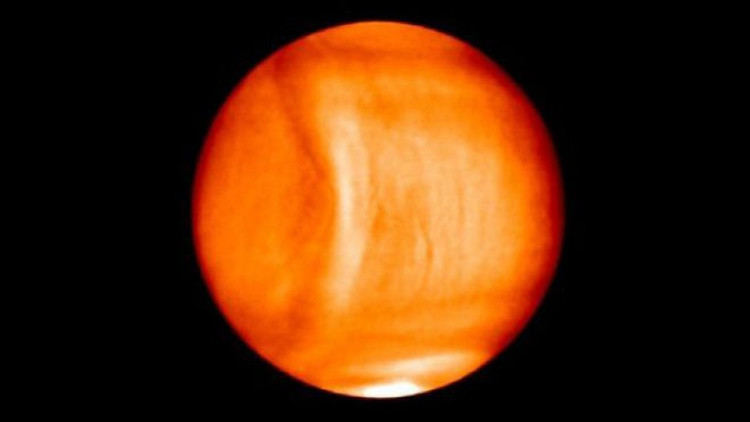Pressure waves on Venus can spread more than 10,000km
Pressure waves in Venus's atmosphere belong to the most powerful pressure wave in the Solar System, spreading farther than 10,000km.
The Japanese Akatsuki probe flew around Venus, sending one image of one of the largest pressure waves ever seen in the Solar System in 4 days of December 2015.
The camera mounted on the ship records a wave that spans more than 10,000km in the atmosphere, from the extreme north across the equator to the south pole of the planet.

The Akatsuki probe captures the giant wave on Venus's clouds in December 2015. (Photo: Planet-C).
Named after the Roman god of beauty and love, Venus, Venus is the second rock planet to count from the Sun and is the hottest planet in the Solar System. Greenhouse effect makes the highest temperature up to 460 degrees C.
Scientists at the Japan Aviation Authority claim that vertical pressure waves (waves generated by interference) in Venus are caused by the wind on the surface hitting the 4,500m Aphrodite Terra mountain near the planet's equator.
"These standing waves can spread very far, perhaps the strongest in the Solar System," the researchers wrote in Nature Geoscience. Unusual waves may even be strong enough to change the planet's climate, scientists added.
The Akatsuki spacecraft uses infrared and ultraviolet cameras to capture giant waves 65km above the ground, inside dense sulfuric acid clouds covering the planet. The wave center lies just above the western slope of the Aphrodite Terra plateau.
On Venus, clouds float at 350 km per hour, much faster than the planet's rotation speed. The planet turns itself too slowly, so a "Venus day" is longer than "a year" there.
Japanese spacecraft began to orbit the planet from December 2015 and took photos of pressure waves sent. Currently the shooting has been stopped so that the ship can perform other tasks.
- Polar regions are cooler than anywhere on Earth
- 10 most interesting things about Venus
- Video: Unusual midnight in hell Venus
- Overview of Venus
- 'Akatsuki' slipped away from Venus due to fuel pressure
- 10 interesting facts about
- Venus can stay?
- The mystery of Venus
- NASA wants to bring people to Venus
- Venus Experss are about to plunge into the Venusian atmosphere
- Venus is about to be a
- Cure high blood pressure with radio waves
 Van Allen's belt and evidence that the Apollo 11 mission to the Moon was myth
Van Allen's belt and evidence that the Apollo 11 mission to the Moon was myth The levels of civilization in the universe (Kardashev scale)
The levels of civilization in the universe (Kardashev scale) Today Mars, the sun and the Earth are aligned
Today Mars, the sun and the Earth are aligned The Amazon owner announced a secret plan to build a space base for thousands of people
The Amazon owner announced a secret plan to build a space base for thousands of people